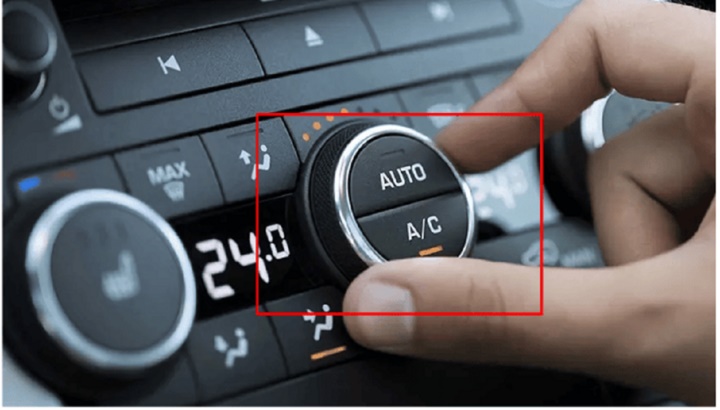Driving in cold, damp, or foggy weather can cause car windows to fog up due to the temperature difference between the outside and inside of the car. If the outside temperature is lower and the air conditioning system generates warm air from the people inside the car, condensation may appear on the surface of the glass.
This affects visibility and increases the risk of accidents.
Use the defogging function

Car windows fog up when driving in rainy or foggy weather, which is very dangerous as it restricts the driver’s visibility. (Illustrative photo).
Most cars nowadays come equipped with a defogging feature. This feature helps dry the glass when it is damp or foggy. So if you notice that your car windows are foggy when it’s raining, activate this windshield defogging feature.
The defogging button is usually located together with the car air conditioning control panel. Note that when turning on the defogging feature, make sure that all car windows are tightly closed. Because if the windows are open, the defogging process will be very slow or ineffective which makes it difficult to remove water droplets on the car windows.
In addition to the front defogging feature, some car models also have a rear defogging feature.
Adjust the air conditioning system
When you notice that the car windshield is foggy due to the condensation obstructing your vision, you should activate the air conditioning system and adjust the temperature gradually to reduce the temperature difference with the outside environment. At the same time, choose the fresh air mode to prevent moist air from outside entering the car.
You need to adjust the air vents so that the air does not blow directly onto the windshield or side windows. The fogging of the windshield is mainly caused by the large temperature difference between the outside and inside of the car. Therefore, to deal with this, just adjust the temperature step by step to reduce this temperature difference.
After a short period of time, when the temperature inside and outside the car is balanced, the moisture level will decrease, and the glass will no longer be foggy.

Adjust the air conditioning system to handle the situation. (Illustrative photo).
Turn on the air fan and the fresh air mode
On dry weather days, the air conditioning system may not work efficiently. To prevent fogging while driving, you can turn on the air fan, switch to the fresh air mode, and adjust the airflow direction.
By doing this, you minimize the temperature difference between the inside and outside of the car, thereby helping the glass to not fog up and enhancing visibility while driving.
Lower the windows
There is no need to lower the windows too much, just lower them to about 10 – 15 cm. This will help balance the temperature inside and outside the car. However, this method should only be applied when it is drizzling and not too cold to avoid affecting the passengers’ health and the interior of the car.
Turn on the windshield wipers
When the car windshield is foggy due to condensation on the outside surface, a quick solution is to turn on the windshield wipers to remove the fog. However, it should be noted that this method may cause the fog to return quickly.
Therefore, for the best results, it is recommended to combine adjusting the air conditioning temperature to prevent the fogging phenomenon on the windshield from recurring.
Apply a water-repellent glass treatment
For cases of heavy and prolonged rain, conventional methods may not achieve the desired effectiveness. In this case, drivers should seek out garages that offer “car window treatment” products with water-repellent functions such as nano spray, nano film, wax, etc., to minimize the fogging of the glass.
Nano spray: This solution is made from ultra-small nanometer-sized particles, which help protect the car windows from dust, scratches, and reduce the strain on the wiper.
Nano film: This film is usually used for the rearview mirrors of the car, helping to repel water and ensure rearview visibility for the driver.
Wax: It has the function of creating a protective layer and resisting water adhesion on the glass surface. Users need to clean the glass before applying the wax, then use a cloth to evenly spread the wax on the surface.
According to VTC news
Ways to Beat the Summer Heat: 10 Cool Strategies
With temperatures soaring to over 40 degrees Celsius in some parts of the northern region, this summer heatwave is causing considerable discomfort and inconvenience. The roads are practically melting in some areas. To keep yourself safe and bearable, here are some tips on how to cope during these hot days.














